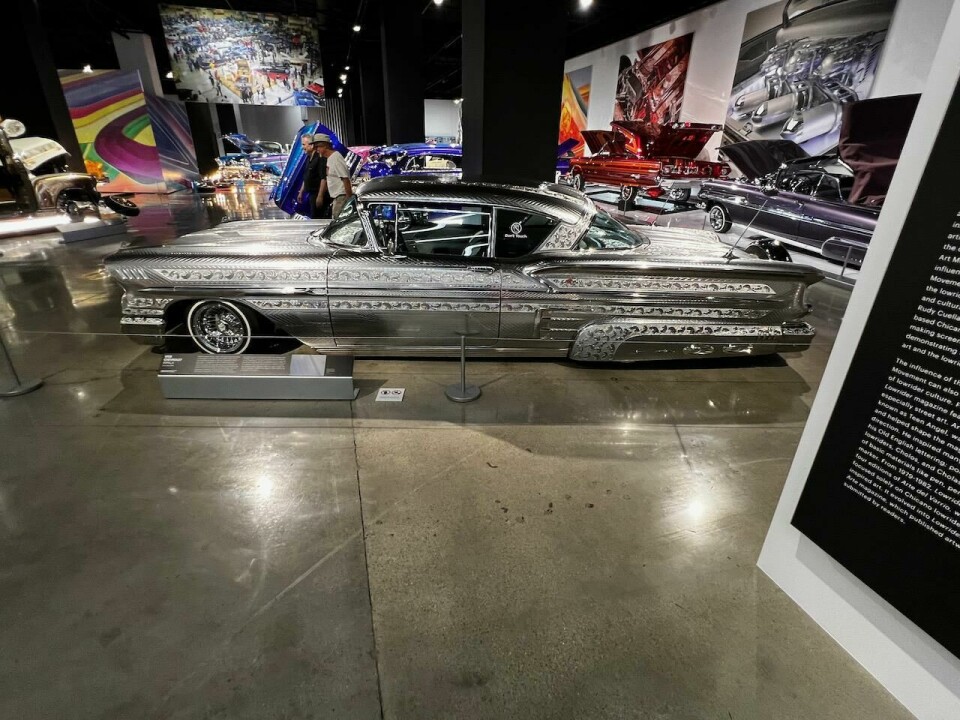
Lowriders cruise into the Petersen
A celebrated part of Latin culture in Los Angeles gets its own major exhibition at the Petersen Museum, gathering muscle cars, choppers and more
Lowriders are a strong part of the motoring culture of Los Angeles and beyond. For the next year, they are the subject of a huge retrospective in the Mullin Grand Salon of the Petersen Automotive Museum in Los Angeles. To be sure, the Petersen has shown lowriders before, but never in such an extensive and wide-ranging exhibit.
Lowriders emerged in Los Angeles in the post-World War II era, paralleling the rise of Hot Rod culture. There is a certain amount of crossover between the two cultures, especially in the ‘resurrection’ of discarded Detroit iron, and the extensive decoration and creative paint jobs. But Lowrider culture is particularly identified and more thoroughly embedded into the history of Chicano/Latin culture than Hot Rods are to other ethnic groups. Additionally, hot rods have a certain ‘outlaw’ reputation, whereas lowriders are seen as a legitimate artistic expression of Latin culture on the streets of LA.
Hot Rods are fundamentally built for speed and power, but lowriders are built to travel ‘low and slow’. They are meant to be seen in detail, not just as a flash screaming by on the strip, hence the highly detailed paint and articulation of parts.
Anyone coming to the Petersen looking for elegant line and form from Maranello or Stuttgart will need to take the elevator to the upper-level galleries. Lowriders are a maximalist art, full of experimental paint colours and compositions, articulated parts like chromed and painted brakes, suspensions, engines, hydraulic fluid and NOS tanks, wheels and all sorts of connections like hinges and lifts.
Indeed, such is the nature of all these parts-as-artwork, that lowriders in shows are frequently shown disassembled, with wheels on the display stand but detached from the car. And underneath the car, mirrors show the extent of the chrome and customisation of the chassis and suspension.
Obviously, the most flambouyant of lowriders are artworks in themselves, a more extreme version of the machines that prowl the streets. The ‘everyday’ machines are sophisticated in themselves, with hydraulic lifts to raise the car to the legal height above the pavement and to allow access into driveways and over speed bumps. They must also pass certain other requirements to roam the roads, and compliance with these regulations has been a considerable source of conflict with the Chicano community and local police departments for decades.
Fortunately, some of these regulations have been abolished, particularly minimum speed and anti-cruising laws, which have become associated with the targeting of minority communities by law enforcement. Latino representation in local and state governments, as well as outreach by local police, has made the lowrider culture more acceptable in recent years, and it now shows in new rules of the road which allow a more diverse automotive fleet than the ubiquitous, plain vanilla sedans.
What to learn from lowriders… Could we envision and design a car that is meant to go slowly?
The favourite canvas of the lowrider is the Chevrolet, particularly the Impala, a long-standing nameplate. The reason was simple: Chevrolets were more affordable as used cars, and after World War II, there were plenty of them around. But other marques became favourites as well. Lincolns and Cadillacs were prized for their length; while Buick and Chevrolet personal luxury cars were appreciated for their premium touches which could be greatly improved with the input of local artisans.
A snooty East Coast art historian might classify lowriders as ‘folk art’, and to a certain extent, they are. Their unique expression of automobility is born of street culture, not in the hothouse of academia. But these are not corncob dolls or Grandma Moses pastorals. Lowriders are sophisticated machines, born of machine culture and refined in the real world of the streets.
And they are also a performance art – cruising the streets, but also ‘hopping’ and dancing on advanced hydraulics, heavily modified suspensions and bodies. Only film, photos and one carefully balanced Buick show this particular quirk of lowrider culture, but it is an amazing thing, that, sadly, is not allowed in the museum.
What can the car designer in a modern OEM studio learn from these cars? Certainly, from a CMF perspective, the creative use of colour inside and out would be nice to see on new cars. Respectable shades of white, grey and black dominate the new car landscape. A little shock of brilliant colour would be nice.
Also, could we envision and design a car that is meant to go slowly? Speed is our obsession, but cruising at low speeds is more of a reality in many areas. Could that find an expression in a new vehicle? It certainly has here in lowrider culture.
Lots to consider here as one walks through a celebration of a formerly outlier (and outlaw) art form of the automotive world. A must-see exhibit if you are in Los Angeles.











































































